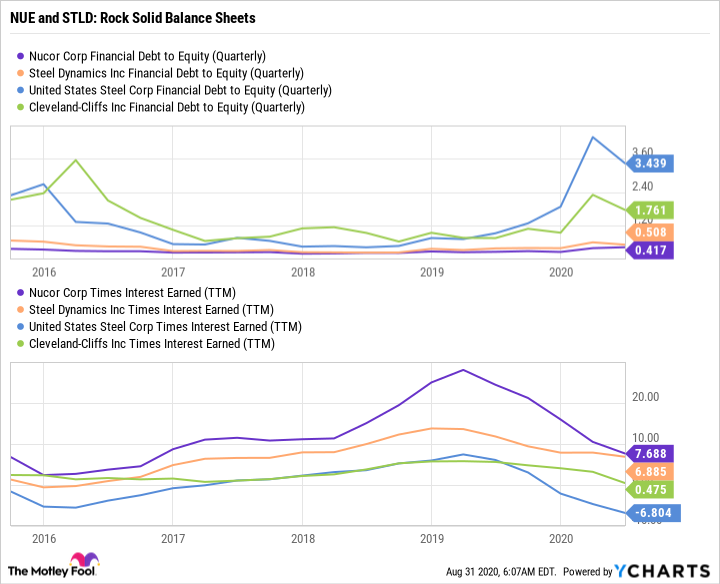If you are looking to own the largest, most diversified, and financially strongest U.S. steelmaker, look no further than Nucor (NUE -0.97%). But there's another name in that sector that is showing that it has a bright future ahead, too: Steel Dynamics (STLD -0.42%). There are a lot of similarities between the two that suggest Steel Dynamics should be on your shortlist along with Nucor, particularly if you're looking for a higher growth rate than slow-and-steady Nucor is likely to offer.
Nucor: A lot to like
Nucor, with a nearly-$14 billion market cap, is a giant in the U.S. steel sector. Its vertically integrated business spans from scrap metal to commodity steel products to specialty steel. A key goal for management is to be the No. 1 or No. 2 player in all of the markets it serves, and it has achieved that goal in 11 sector niches. Another focus is to increase its scale in higher-margin products so it can use more of the steel it produces in increasingly profitable ways.

Image source: Getty Images.
One of the biggest signs of Nucor's long-term success, however, can be found in its incredible dividend history. Despite the fact that steel is a highly cyclical industry, Nucor has increased its dividend annually for 47 consecutive years. Nucor is clearly doing something right. Before you call it day and buy Nucor, however, you should take a closer look at Steel Dynamics. This growing mill is quickly looking like it will be the next Nucor.
Some inside-baseball talk about the steel industry
One of the first things to understand about Steel Dynamics is that it has a bit of inside information about what it takes to be a great steel company -- it was co-founded by a former Nucor employee. CEO Mark Millett literally has 12 years' worth of hands-on experience doing things the Nucor way. So it's not shocking that Steel Dynamics is following in Nucor's footsteps.
For example, the two are both focused on electric arc steel mills. These mills are more flexible than older blast furnace technology. They are both vertically integrated, with material scrap metal operations to help ensure they have access to this key steel-making input. And Steel Dynamics has been focusing on expanding its higher-margin steel fabrication business, just like Nucor, to generate the best returns possible from the commodity steel it produces.
NUE Financial Debt to Equity (Quarterly) data by YCharts
But the similarities don't stop at the business model. Nucor is a fiscally conservative company, which allows it to invest during industry downturns to come out the other side a stronger competitor. Steel Dynamics' balance sheet is rock-solid as well, allowing it to do the same thing. It currently has a material new mill under construction, just like Nucor. So not only are these two companies financially prepared to deal with industry headwinds, they are actually ready to take advantage of tough times, sporting industry-leading financial-debt-to-equity ratios and interest coverage.
NUE Dividend Per Share (Quarterly) data by YCharts
Meanwhile, the dividend is another key similarity. Steel Dynamics is now up to a decade of annual dividend increases. But this is also where there's a very big divergence: Nucor's annualized dividend growth over the past decade is in the low single digits. Steel Dynamics' dividend has grown at around 10% a year over that span. With a younger business and a market cap of just $6 billion or so (half that of Nucor's), it's understandable that Steel Dynamics can grow at a faster clip than the industry giant. However, for investors focused on dividend growth, that may be the edge that tips them toward an investment in Steel Dynamics. Both, meanwhile, offer dividend yields in the mid-3% range today.
Steel Dynamics: Get to know this up and comer
To be fair, slow and steady might be the better option for some conservative investors. So don't nix Nucor just because of a slow-growing dividend. It possesses size, scale, and diversification that Steel Dynamics does not at this point in its life, and it will take a long time for Steel Dynamics to catch up. However, if you can stomach a little more risk, then Steel Dynamics might be worth a deep dive, as it looks to gain ground on the industry leader by following a roughly similar playbook.







